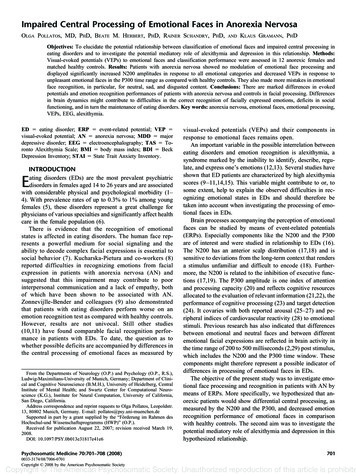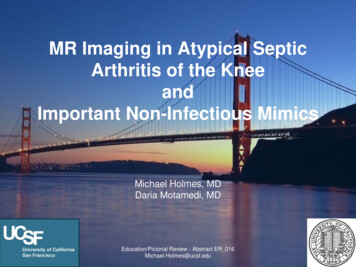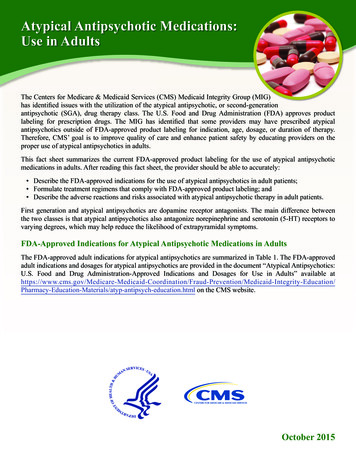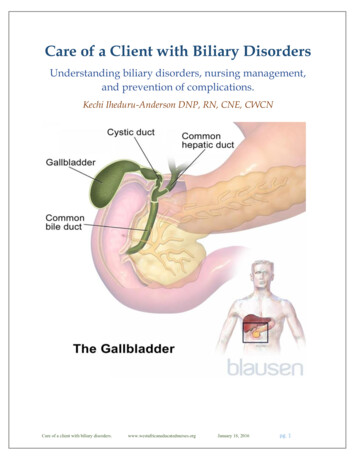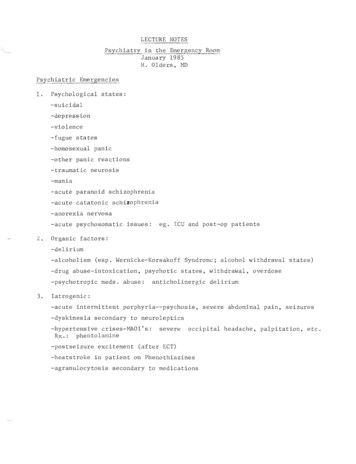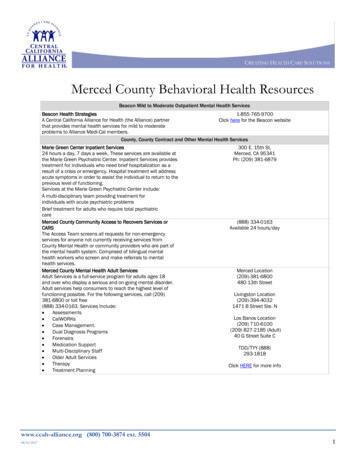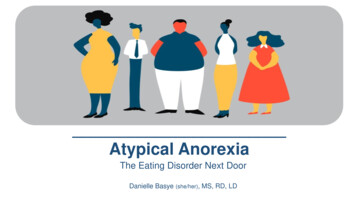
Transcription
Atypical AnorexiaThe Eating Disorder Next DoorDanielle Basye (she/her), MS, RD, LD
A little about me . Anti-Diet dietitian In the field almost 5 years Masters degree Idaho State University Yoga Bee keeper Idaho native2
Objectives Participants will be able to identify signs and symptoms of anorexianervosa and atypical anorexia nervosa Participants will be able to name at least three risk factors that maycontribute in the development of an eating disorder Participants will be able to identify three ways to facilitate a healthyrelationship with food3
Fast Facts About Eating Disorders Eating disorders are estimated to affect around 9% of the population Estimated that 28.8 million Americans will suffer from an eatingdisorder in their lifetime Anorexia Nervosa, highest mortality rate of any psychiatric illness Estimated economic cost 64.7 billion per year (2018-2019) Affect people of all ages, races, ethnicities, genders, sexual orientations The prevalence of lifetime obesity in ED cases was 28.8% (2012) (ranging from 5% in anorexia nervosa to 87% in binge-eating disorders)4
Who is at Risk? History of dieting Family/personal history of mentalhealth conditions Body and weight concerns Weight focused sports/activities Dance, gymnastics, wrestling, pageants5
Who is at Risk? Family history of eating disorders Experiencing weight stigma Bullying, teasing, early development Personality traits-perfectionism Behavioral/mental inflexibility Experiencing trauma Social environment6
What is Anorexia Nervosa (AN)? “Traditional” eating disorder See themselves as “overweight” despitebeing at a very low weight Fear of gaining weight Restriction of food low body weight Lack of awareness of dangers of a lowbody weight Menstruation requirements removed inupdated manual-2013 BMI at or below 177
Atypical Anorexia Nervosa Under criteria Other Specified Feeding and Eating Disorder (OSFED) The catch all diagnosis Clinically significant but doesn’t fit into other categories Meets psychological criteria Same as Anorexia Nervosa but: Weight is within normal or above normal range: using body mass index (BMI) May not have significant weight loss Haven’t met Anorexia Nervosa criteria in the past Eating patterns and behaviors impair functioning and cause distress Social: skip eating out with friends, worried about traveling, avoid social events Constant thoughts about food, weight, body, calories Distress if presented with meal outside of rigid rules8
What We Know about Atypical Anorexia Adolescents who are “obese” show higher incidences of disorderedeating behaviors One study showed (AAN vs. AN)* No significant difference between low heart rate or abnormal blood pressure More weight loss over a longer period of time Many disordered eating behaviors are recommended to people inhigher weights---more socially acceptable Challenges in receiving a diagnosis Weight stigma Social/medical pursuit for thinness*AAN: Atypical Anorexia Nervosa*AN: Anorexia Nervosa9
History of the BMI Adolphe Quetelet Astronomer, statistician, etc. Created in early 1800’s- became moreglobally used in the 70’s Find the “average” man, “social averages” Young white adults10
Problems with BMI Weight focused care not effective for treating eating disorders Some exceptions with those who are medically underweight May miss diagnosing someone with an eating disorder if only focusing on outward appearance Many with eating disorders may not show external physical signs/symptoms of an eating disorder You may be at a “normal BMI” but be at an individually suppressed weight Based on probability and statistics-not medicine Not meant to be a diagnostic tool Perpetuates weight stigma Not the end all be all measure of health Why is it used? Free , easy, categorical, and universal11
Restriction at Any Size Starvation: Energy consumed over period of timeis not sufficient to the body’s needs Can happen at any body size Altered metabolism- body slows down toconserve energy Alter hormone production Cessation of menstrual cycle, impact bonedensity body temperature, blood sugar Unhappy gut-constipation, bloating, gas,slow motility Stunt growth and normal development inchildren and adolescents Muscle wasting/loss: the heart is animportant muscle! Preoccupation with food Altered hunger/fullness cues Psychological functioning: depression, anxiety,mood swings, and personality changes Hair loss12
Access to Treatment MisdiagnosisEstimated only 20-30% receive treatmentNeed to become “sick enough” to access careImpact insurance coverageEating disorders in high weights may not be taken as seriouslyFemales are more likely to receive diagnosis and treatment vs. malesThose who are “underweight” more likely to receive diagnosis and treatmentOne study found three personal barriers:1.2.3.I can do this one my ownI don’t have a need for therapy/counselingNot sure how serious my needs are13
Building a Healthy Relationship with Food Intuitive Eating Self-care framework for eating Focus on function vs. appearance Health promoting behaviors Food provides more than nutrition Social, cultural, pleasure, emotion Self compassion Nutrition should be a tool, not a weapon
Seeking Help Professionals who can help Dietitians Therapist/counselor/social worker Primary care provider Everyone deserves help Find someone who has experience witheating disorders Eating Attitudes Test (EAT-26)15
ResourcesPodcasts Maintenance Phase (explicit) Food Psych Nutrition MattersBooks Intuitive Eating, By: Evelyn Tribole & Elyse ReschSick Enough, By: Dr. GaudianiAlmost Anorexic, By: Jennifer Thomas and Jenni SchaeferAnti-Diet, By: Christy HarrisonFood is Not Medicine ,By: Dr. Joshua Wolrich16
References American Psychiatric Association. (2013). Diagnostic and Statistical Manual for Mental Health Disorders. In Feeding and Eating Disorders (5th ed., pp. 338–354). American Psychiatric Publishing. Arcelus, Jon et al. “Mortality rates in patients with anorexia nervosa and other eating disorders. A meta-analysis of 36 studies.” Archives of general psychiatry 68,7 (2011): 72431. https://doi.org/10.1001/archgenpsychiatry.2011.74 Blackburn H, Jacobs D Jr. Commentary: Origins and evolution of body mass index (BMI): continuing saga. Int J Epidemiol. 2014;43:665–669. Deloitte Access Economics. The Social and Economic Cost of Eating Disorders in the United States of America: A Report for the Strategic Training Initiative for the Prevention of Eating Disorders and the Academy for Eating Disorders. June2020. Available at: ic-costs-of-eating-disorders/. Eiring, K., Wiig Hage, T. & Reas, D.L. Exploring the experience of being viewed as “not sick enough”: a qualitative study of women recovered from anorexia nervosa or atypical anorexia nervosa. J Eat Disord 9, 142 (2021).https://doi.org/10.1186/s40337-021-00495-5 Forney KJ, Brown TA, Holland-Carter LA, Kennedy GA, Keel PK. Defining "significant weight loss" in atypical anorexia nervosa. Int J Eat Disord. 2017 Aug;50(8):952-962. doi: 10.1002/eat.22717. Epub 2017 Apr 24. PMID:28436084. Forrest, L. N., Smith, A. R., & Swanson, S. A. (2017). Characteristics of seeking treatment among U.S. adolescents with eating disorders. International Journal of Eating Disorders, 50(7), 826–833. https://doi.org/10.1002/eat.22702 Gaudiani, J. L. (2019). Sick enough: A guide to the medical complications of eating disorders. Nagata, J.M., Garber, A.K., Tabler, J.L. et al. Prevalence and correlates of disordered eating behaviors among young adults with overweight or obesity. Journal for General Internal Medicine. 33, 1337–1343 (2018).https://doi.org/10.1007/s11606-018-4465-z National Eating Disorders Association. (2018, August 3). Risk Factors. rs Nuttall F. Q. (2015). Body Mass Index: Obesity, BMI, and Health: A Critical Review. Nutrition today, 50(3), 117–128. https://doi.org/10.1097/NT.0000000000000092 Sawyer SM, Whitelaw M, Le Grange D, Yeo M, & Hughes EK (2016). Physical and psychological morbidity in adolescents with atypical anorexia nervosa. Pediatrics, 137(4), 4080 Epub 2016 Mar 29. doi:10.1542/peds.2015-4080[doi] Sonneville, K R, and S K Lipson. “Disparities in Eating Disorder Diagnosis and Treatment According to Weight Status, Race/ethnicity, Socioeconomic Background, and Sex Among College Students.” The international journal ofeating disorders. 51.6 (2018): 518–526. Web. Smink, F.R.E., van Hoeken, D. & Hoek, H.W. Epidemiology of Eating Disorders: Incidence, Prevalence and Mortality Rates. Curr Psychiatry Rep 14, 406–414 (2012). https://doi.org/10.1007/s11920-012-0282-y Stang, A. J. (2022). Is it Time to Say Goodbye to BMI?. Plastic and Reconstructive Surgery Global Open, 10(1). Substance Abuse and Mental Health Services Administration. DSM-5 Changes: Implications for Child Serious Emotional Disturbance [Internet]. Rockville (MD): Substance Abuse and Mental Health Services Administration (US);2016 Jun. Table 19, DSM-IV to DSM-5 Anorexia Nervosa Comparison. Available from: /ch3.t15/17
Books Intuitive Eating, By: Evelyn Tribole & Elyse Resch Sick Enough, By: Dr. Gaudiani Almost Anorexic, By: Jennifer Thomas and Jenni Schaefer Anti-Diet, By: Christy Harrison Food is Not Medicine ,By: Dr. Joshua Wolrich 16

